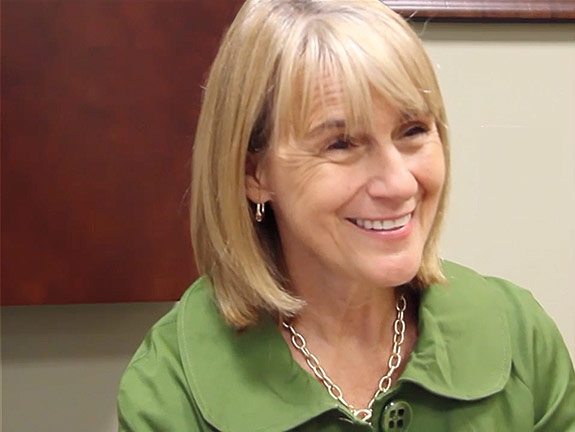Joanne Hanley ’80 never expected that a master’s degree in environmental science would lead her to Gettysburg—one of the most significant sites in American history—or to supporting and creating several other memorials along the way.
During a 32-year career with the National Park Service, Hanley worked at more than a dozen historically and environmentally significant locations throughout the country. She oversaw the fundraising, design, and construction of the Flight 93 memorial to commemorate the September 11, 2001, crash. And, after serving as superintendent of the National Parks of Western Pennsylvania for a decade, she turned her energies to the field where a pivotal battle of the Civil War was fought in 1863.

The Gettysburg Foundation runs the only privately owned and operated visitor center in the National Park Service, and in 2010 the nonprofit’s board saw in Hanley’s experience with park service partnerships and nationally significant sites “the perfect leadership mix,” said foundation chairman Robert A. Kinsley.
As president, Hanley works hand-in-hand with the park service, managing the $103 million Gettysburg National Military Park Museum and Visitor Center. With 140,000 square feet of exhibits, the 1883 cyclorama painting of the battlefield, and food court, the visitor center is where “the Gettysburg experience” begins for most.
After we visit in her office, located above the visitor center, Hanley insists that I see the 20-minute film, narrated by Morgan Freeman, and cyclorama show, if nothing else, on my way out. She adds that, since the center was expanded to include a dozen museum galleries, most people stay overnight to take it all in.
“There’s just so much,” she says. “You can’t do Gettysburg in a day.”
When she first came on board, Hanley knew the foundation—one of the largest and most successful private organizations in the park service, with an annual budget around $13 million—represented a unique opportunity to “preserve these very special places.”
She had most recently overseen the development of the new Flight 93 National Memorial and served as its superintendent for a decade. Designing the memorial meant forging close relationships with family members of the 40 people who lost their lives in the crash. If not for the efforts of passengers to overwhelm the hijackers, the plane would have been the fourth to hit a U.S. landmark that day.
“It was a life-changing experience,” Hanley says of creating the memorial in rural southwestern Pennsylvania. “Nothing up until that point in my life ever came close to doing what we did.”
Hanley recalls the words that have been spoken every year on the anniversary of September 11 at the Flight 93 memorial. Quoting President Abraham Lincoln at Gettysburg, “Someone would always point to the crash site and say, ‘The world will little note nor long remember what we say here, but it will never forget what they did here.’”
“I really feel strongly that those words of the Gettysburg address are not only true here and at the 9/11 site, but about any battlefield where Americans have fought to preserve freedom,” she says.
As an environmental science student at WSU in the 1970s, Hanley never imagined herself in a position like this, quoting Lincoln’s patriotic speech as often as she does. She hadn’t imagined herself building an entire park, or working for the park service for that matter.
Biologist Robert Jonas, Hanley’s academic advisor, was the first to plant the idea. Jonas spent his summers as a seasonal park ranger at Yellowstone National Park and urged Hanley to apply her interest in natural resources to a park service internship.
Midway through her master’s program, Hanley spent a year as an environmental specialist at the Denver Service Center, creating environmental impact statements and assessing new construction projects at the central hub for designing new national parks.
The mission of the park service quickly became her own.
“It’s been said that the national parks are America’s greatest invention, and I think she was very much a part of that spirit and commitment,” says Frederick Steiner, one of Hanley’s WSU professors. “She certainly had an idealism that was very strong as a student and carried into her career.”
Steiner, now the dean of the school of architecture at the University of Texas at Austin, crossed paths with Hanley 20 years after her graduation.
She was overseeing a national design competition at the time to determine the look and feel of the Flight 93 memorial when a familiar name rose to the top five list of finalists. Out of more than 1,000 design entries, Steiner’s submission with his university colleagues stood out.
“It was a pleasant surprise,” Hanley says.
She called Steiner herself to tell him the good news, mentioning her maiden name to jog his memory. Though another design was awarded the final contract, Steiner kept track of Hanley’s progress as she oversaw construction of the Flight 93 monument, largely completed in 2011.
“I think it’s quite an accomplishment in this day and age to create a national monument, especially given the gravity of that particular topic,” he says.
Hanley now sees public-private partnerships like the one that runs Gettysburg as key to funding the preservation of public places. Most of the one million annual visitors to Gettysburg—deemed the No. 1 destination in America by TripAdvisor.com users—don’t realize it’s run by a private organization.
Hanley says that’s fine. She’d never want to see federal funding for these places entirely replaced, “because these places are public treasures.”
